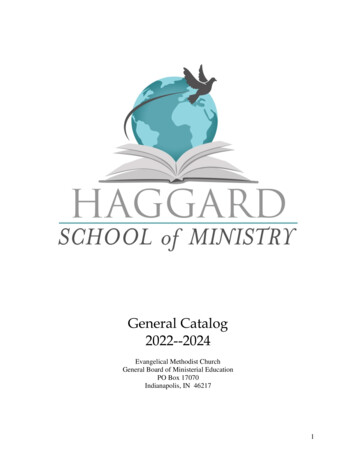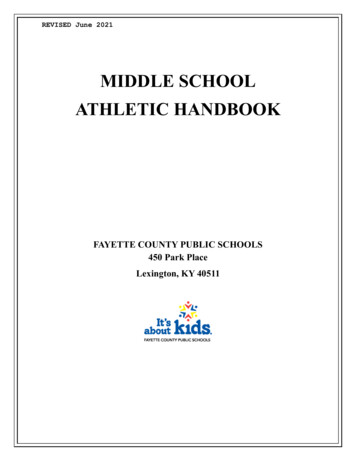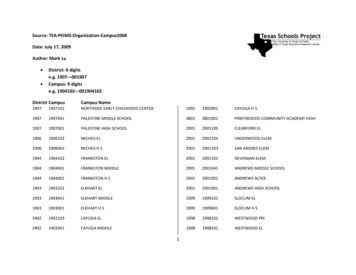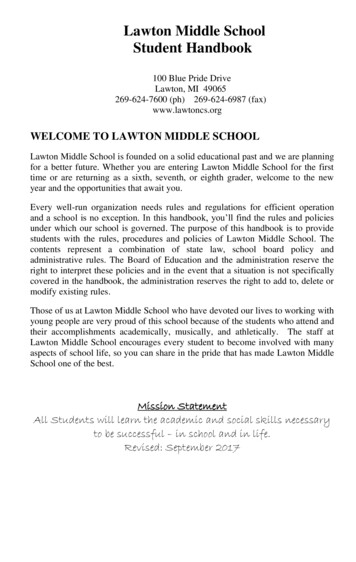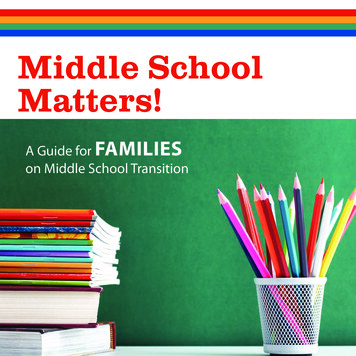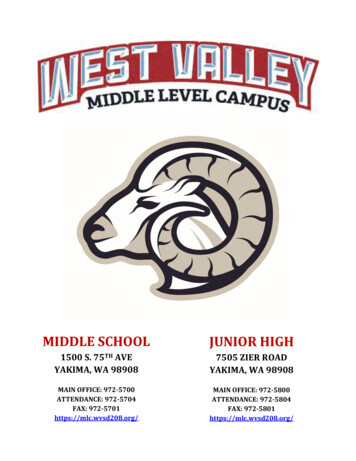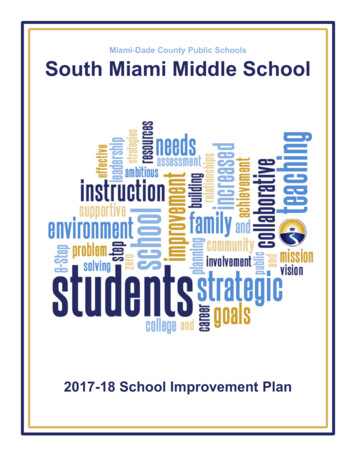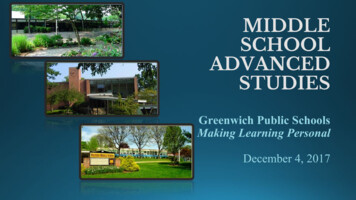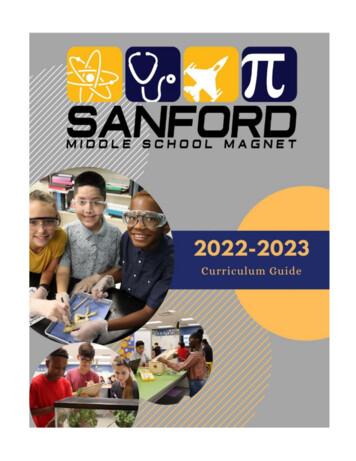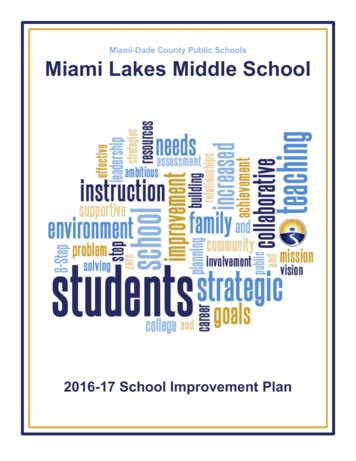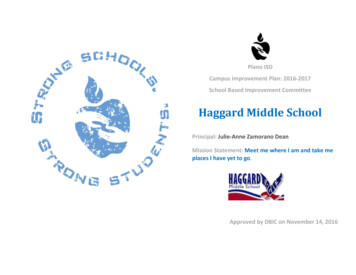
Transcription
Plano ISDCampus Improvement Plan: 2016-2017School Based Improvement CommitteeHaggard Middle SchoolPrincipal: Julie-Anne Zamorano DeanMission Statement: Meet me where I am and take meplaces I have yet to go.Approved by DBIC on November 14, 2016
Middle School Campus Improvement Plan 2016-2017 Haggard Middle SchoolVerification PagePlanning Timelines Analysis of Critical Actions, and STAAR 2015-2016 Gap Analyses: August 2016Needs analysis, goal setting and strategic planning: July - September 2016Campus teacher data analysis day: August - September , 2016SBIC Plan due for DBIC review: October 12, 2016Meeting Dates Meeting 1: SBIC approves the improvement plan (by October 7, 2016): Tuesday, September 20, 2016Meeting 2: Progress monitoring and review of strategic plan (by February 1, 2017): Wednesday, January 11, 2017Meeting 3: Evaluate effectiveness of implementation of strategic plan and meeting of goals (by June 9, 2017): Wednesday, May 31, 20172016-2017 Campus StatusCheck all that apply Title III English Language Learner Campus Non-Title I Campus Title I School-wide CampusTitle I InformationTitle I Components1 (CNA)Comprehensive Needs Assessment6 (PI)Strategies to Increase Parental Involvement2 (RS)Reform Strategies7 (Tran)Transition (Elementary schools only)3 (HQ)Instruction by State Certified Staff8 (A)Teacher Decision-Making Regarding Assessments4 (PD)High-Quality Professional Development9 (M)Effective and Timely Assistance to Students5 (R/R)Strategies to Attract State Certified Teachers10 (Coord)Coordination and IntegrationProgram FundingStaffing Enter funding Parental Engagement Enter funding Student and CampusEnter funding Capacity Buildingi.e. Teacheri.e. Parent programs, RAMP up for Kindergarten Programi.e. Tutoring, adult temp staff to support students during instruction, professional development, PLC,student enrichment opportunitiesPage 2 of 23
Middle School Campus Improvement Plan 2016-2017 Haggard Middle SchoolSBIC CommitteeCommittee Member’s NameRoleYear 1stParticipatedon SBICMeeting 1AttendanceMeeting 2AttendanceMeeting 3AttendanceRebecca AbsalonFaculty Member20169/20/161/11/175/31/17Allen HarrisFaculty Member20169/20/161/11/17Not presentMegan HowardFaculty Member20169/20/161/11/175/31/17Teresa SmithFaculty Member20169/20/161/11/175/31/17Thomas FultonFaculty Member20169/20/161/11/17Not presentCourtney PittsFaculty Member, Special Education20169/20/161/11/175/31/17Julie-Anne Zamorano DeanPrincipal20009/20/161/11/175/31/17Ashley HelmsDistrict Professional2016Not presentNot present5/31/17Blair WentworthCampus Professional, Non-teaching20169/20/161/11/175/31/17Timothy LambertSupport Staff Member20169/20/161/11/17Not presentGlenda CopelandParent-Selected by PTA20169/20/161/11/175/31/17Christie HuckabyParent-Selected by Principal20169/20/161/11/175/31/17Christine PetersParent2016Not presentNot presentNot presentBrittany GaskillParent2016Not presentNot presentNot presentAngie HickeyParent20169/20/161/11/175/31/17Cathy MayParent20169/20/16Not presentNot presentPhil WentworthCommunity Member20169/20/161/11/175/31/17(Waiting on confirmation)Community MemberMr. LanceBusiness Representative2016Not presentNot presentNot presentMr. Ben NeupertBusiness Representative2016Not presentNot present5/31/17Information regarding the SBIC Committee (BQB Local) may be accessed here: http://pol.tasb.org/Policy/Code/312?filter BQBPage 3 of 23
Middle School Campus Improvement Plan 2016-2017 Haggard Middle SchoolDistrict-Wide Goals1. Increase the percentage of students meeting STAAR Satisfactory performance rates.2. Ensure that all students meet STAAR and MAP Growth Standards in all subject areas.3. Increase Satisfactory and Advanced performance rates for Economically Disadvantaged student group – Closing Performance Gaps.4. Increase the percentage of students meeting STAAR Advanced performance rates.5. Increase high school graduation rates and ensure students are on track to graduate.6. Ensure that all students graduate College and Career Ready or are on track to College and Career Readiness.7. Ensure that all student groups (7 race/ethnicity and Sp.Ed, ELL, ED) meet the Accountability Safeguard measures (60% meet the Level II SatisfactoryStandard on STAAR/EOC).District-Wide GoalsTitle I ComponentsApplicable StudentGroupsHealth, Fitness and Attendance:The campus will utilize their coordinated health program and analyze their studentfitness data to set goals and objectives to encourage the health, fitness and attendanceof their students.10 (Coordination and Integration)AllViolence Prevention and Bullying10 (Coordination and Integration)AllParental Involvement:The campus will provide a program to encourage and increase participation of parentsin regular, two-way and meaningful communication involving student academic learningand school activities.1 (Comprehensive Needs Assessment)6 (Strategies to Increase Parental Involvement)All10 (Coordination and Integration)1 (Comprehensive Needs Assessment)Highly Qualified Staff:The rate of state certified teachers and highly qualified paraprofessionals will meet the100% target measure.3 (Instruction by State Certified Staff)4 (High-Quality Professional Development)All5 (Strategies to Attract State Certified Teachers)10 (Coordination and Integration)Transition of Pre-KN Students:The transition from early childhood to elementary school is supported by the campusand district. (Title I Campuses only)1 (Comprehensive Needs Assessment)7 (Transition)10 (Coordination and Integration)Title I onlyPage 4 of 23
Middle School Campus Improvement Plan 2016-2017 Haggard Middle SchoolImprovement Plan Critical ActionsThe areas for school-wide and/or targeted core-subject Critical Actions were identified using the following sources: Comprehensive Needs Assessment; Plano Professional Practice Analysis (P3A School Wide and Classroom Level); STAAR/EOC Gap Analysis; State of Texas Accountability Reports (specifically addressing any student groups that did not meet State and Federal Accountability Safeguards)School Wide and/or Targeted Grade Level Critical Actions1.Adjust to add depth to learning opportunities for students who demonstrate early mastery of learning objectives. (BP 15)2. Participate in peer classroom visits in order to improve the instructional practices of the team. (BP 5)3.4.5.Page 5 of 23
Middle School Campus Improvement Plan 2016-2017 Haggard Middle SchoolCritical Action 1Critical Action: Adjust to add depth to learning opportunities for students who demonstrate early mastery of learning objectives. (BP 15)Project Lead:Staff, Title I Staff:Materials and Resources:TargetedArea: School-wideJulie-Anne Z. Dean (principal), Brooks Baca (Assistant Principal) & Linda Washington (Assistant Principal)Rebecca Grant (math chair) & math teachers, Andee Hirsch (science chair) & science teachers, Logan Miller (history chair), history & PACEteachers, Kim Hicks (English chair) & English teachersPPPA Survey, SBIC, iLead Meetings, Department Meetings, PLCS, Peer Coaching, PACE teachers, District Instructional Leaders Reading Writing ELA Mathematics Science Social Studies Other:Strategies for Accomplishing Critical Action 1Action Step(Title I Component # and Funding Amounts per Action Step)ImplementationTimelineper Action StepImplementationEvidenceper Action StepExtend learning for students who demonstrate earlymasteryFormative & Summative Notesper Action StepMathExit cards1.2.3.Help teachers distinguish between gifted students andthose who have demonstrated early mastery of grade-levellearning objectives. How do teachers determine whichstudents have already mastered particular objectives? Is asystem of pre-tests in place?Investigate the approaches teachers take in addressingstudents who demonstrate early mastery. Do they planactivities that extend students' thinking for any objective onwhich they demonstrate early mastery? This approachsuggests a "deeper, not wider" approach. Students whodemonstrate early mastery are sometimes providedunstructured time to study one of their interest areas.While not inherently bad, this open-ended learningopportunity does not ensure that students will be engagedin the type of activity that will seriously extend theirthinking.Work with teacher teams to add a consideration of earlymastery students in their instructional planning. Have teammembers brainstorm the extended learning opportunitiesthat will be provided for these students. New learningOnce a month atgrade levelacademic teammeetingsOctober 2016December 2016Once a month atgrade levelacademic teammeetingsOctober 2016December 2016MonthlydepartmentmeetingsOctober 2016-th6 Grade .Oct2016 .gave apretest to Honorsover proportionth(7 gradeTEK .2% knowallLocal assessments(quizzes, tests,informalassessments), MAPtesting, academicteam PLC notes,grade level subjectplanning notesLesson plans,curriculumComprehension Checks .prior to a quiz to showcomprehensionExtension lessons and questions from Carnegie .everychapterEnrichment problems for HonorsJoin Math CountsSynthesis/Extension .all on the Teacher Topic pages inCurriculum plannerScienceWe address questions on a higher level using Costa’s 3Levels of Questioning skill sheet and have studentspractice creating questions themselvesWe address questions on a higher level of bloomsPage 6 of 23
Middle School Campus Improvement Plan 2016-2017 Haggard Middle SchoolAction Step(Title I Component # and Funding Amounts per Action Step)opportunities and activities should be carefully crafted torequire deeper levels of thinking and investigation relativeto the same standard for which they have demonstratedmastery. This means that options for students who needmore challenging material must be 1) tightly aligned to thelearning objectives of the written curriculum and 2)specifically assigned to students based on the learningobjectives where they have demonstrated early mastery.4.If your district has not already provided teachers withthese types of early-mastery materials relative to eachacademic objective, then certainly ask district leaders ifthis is a possibility.ImplementationTimelineper Action StepMay 2017.Monthly at iLeadand principals’meetingsOctober 2016May 2017ImplementationEvidenceper Action Stepplanners,department PLCnotes, grade levelsubject planningnotes, andconference noteswith Gifted andTalented teachers.Lesson plans,curriculumplanners,department PLCnotes, grade levelsubject planningnotesand conferencenotes with Giftedand Talentedteachers.Formative & Summative Notesper Action Step(especially using C-notes) and have them challengedwith predictions and hypothetical situationsSocial StudiesConsistently monitoring, assessing student success(Not formal) pretestingClass discussion of topic to survey students’ priorknowledgeWorking with students on an individual basisWarm up time for gauging student understandingPair higher level students with lower level students tocomplement both learnersPrepare optional assignment to enforce learningStudent choice in assignmentsMSP- suggested activitiesExtension activities based on student interest (ex:investigate the music of the WWII era, design clothingthat might have been worn during the Medieval era,research foods served in Ancient Rome, etc.)EnglishExit cardsExit cards and comprehension notesPre-reading Anticipation guides about topics and themesstudents will encounter in a readingHigher order thinking tasks in HonorsJan 2017Identify specific work products/outcomes for extendedlearning1.Collect samples of extended learning activities thatteachers are currently using to gauge the amount ofstructure provided in those assignments. Summarize yourMathMonthlydepartmentmeetingsOctober 2016-One per grade level .show examples .Exit cards,extension questions, etcEnrichment questionsPage 7 of 23
Middle School Campus Improvement Plan 2016-2017 Haggard Middle SchoolAction Step(Title I Component # and Funding Amounts per Action Step)observations relative to the specificity of the assignments'purpose and desired outcomes. Share your observationswith your leadership team and with your faculty.2.3.Encourage teachers to work with their teams to define thework products and outcomes that will be expected for anyextended learning opportunities in their classrooms.Oftentimes, when students are "ahead," they are allowedto work on projects that have no clear level of outcomespecified. What type of student work would clearlydemonstrate the desired level of student thinking forindependent projects? Teachers should be clear andspecific about what type of evidence they will accept toshow that participating students did, indeed, extend theirthinking.If extended opportunities are not already provided in thedistrict's written curriculum resources, work with districtleaders to request this type of support.ImplementationTimelineper Action StepMay 2017ImplementationEvidenceper Action StepFormative & Summative Notesper Action StepScienceWe address questions on a higher level of blooms(especially using C-notes) and have them challengedwith predictions and hypothetical situationsOnce a monthat grade levelacademic teammeetingsOctober 2016May 2017We also incorporate STAAR released test questions inunit testsSocial StudiesMSP- suggested activitiesExtension activities based on student interest (ex:investigate the music of the WWII era, design clothingthat might have been worn during the Medieval era,research foods served in Ancient Rome, etc.)Summer 2017Student choice in assignmentsEnglishEncourage teachers to attend PD over summer relatedto GT strategies and mindsetthGrowth mindset discussion in 6 grade classesWork collectively to challenge students who demonstrateearly mastery1.2.Examine the ways that teachers in your school currentlycollaborate to assist students in their classrooms whodemonstrate early mastery of grade-level objectives. Askall teachers to specify exactly how they team with peers toaddress the needs of these students. Discuss theresponses in a school leadership meeting.Meet with teacher teams to review the way teachersOnce a month atgrade levelacademic teammeetingsOctober 2016December 2016CurriculumsoftwareprogramsMathEncourage Math CountsEnrichment problemsYummy math .comth6 .Ty H and Josiah GOnce a month atPage 8 of 23
Middle School Campus Improvement Plan 2016-2017 Haggard Middle SchoolAction Step(Title I Component # and Funding Amounts per Action Step)indicate they are currently collaborating. Identify anyoutstanding examples of collaboration to share with theentire faculty.3.Ask each team to design an activity to increase thispractice in your school. Have teachers team with otherteachers of the same grade and subject to regroupstudents who show early mastery of any given academicobjective. This practice describes a potentially powerfullearning opportunity for students who demonstrate earlymastery of any particular academic objective(s). Followinga pre-test, regroup (across classrooms) those studentswho already show mastery of the knowledge and skills tobe covered. Perhaps six different students across threeclassrooms will be identified. Group these students andprovide a well-structured project to take their knowledgeand skills to a deeper level on the learning objective.Perhaps the group can work together in the library or adesignated learning lab where another adult can provideeven greater stimulation.ImplementationTimelineper Action Stepgrade levelacademic teammeetingsOctober 2016May 2017Every othermonth at staffmeetingNovember 2016May 2017ImplementationEvidenceper Action StepFormative & Summative Notesper Action Stepth7Sai and Rachelth8 .Darby H and Scout RScienceGrade level partners meet during planning period once aweek to collaborate and discuss new learningopportunities; we are continuously re-evaluating rubricsand assignments to ensure the concept is fully exploredSocial StudiesWork with Social Studies team to understand what eachteam is doing to extend learning and share ideas.EnglishEncourage honors for PACE/GT studentsPage 9 of 23
Middle School Campus Improvement Plan 2016-2017 Haggard Middle SchoolCritical Action 2Critical Action: Participate in peer classroom visits in order to improve the instructional practices of the team. (BP 5)Project Lead:Staff, Title I Staff:Materials and Resources:Targeted School-wideArea:Julie- Anne Zamorano Dean (principal), Brooks Baca (Assistant Principal), & Linda Washington (Assistant Principal)Kim Hicks (English chair) and English teachers, Andee Hirsch (science chair) and science teachers.PPPA Survey, SBIC, Conference Periods, PLCS, Peer Coaching, Department Meetings Reading Writing ELA Mathematics Science Social Studies Other:Strategies for Accomplishing Critical Action 2:Action Step(Title I Component # and Funding Amounts per Action Step)ImplementationTimelineper Action StepImplementationEvidenceper Action StepScienceVisit other classrooms as part of collaborative process1.2.3.Provide opportunities for teachers to visit other teammembers' classrooms. Make observation of peerinstruction a regular part of the collaborative planningprocess for each grade-level or subject-area team. That is,observing a peer should not only be a professional growthopportunity for teachers who are experiencing difficulties inthe classroom. Instead, have all teachers schedule visitsto other team members' classrooms as part of the way youdo business in your school.One visit perteacher eachsemesterNovember 2016May 2017Ask each teacher to schedule a single period ofobservation time with another team member. If necessary,provide a substitute to allow time for the observations.Have team members coordinate their planning so that oneday of substitute time could provide the opportunity for fouror five teachers to observe. If you cannot provide asubstitute, have various school leaders cover a class ortwo to provide this opportunity. (In fact, it may buildstronger learning relationships with teachers if schoolleaders—rather than substitutes—cover classes as theteachers observe one another.)One visit perteacher eachsemesterNovember 2016May 2017Provide structured time for teachers to debrief following avisit. Model the type of debriefing that should occur. Inparticular, help teachers to talk openly about what did anddidn't work during the observed lesson. Teachers tend toFormative & Summative Notesper Action StepChallenging with only one off-periodUse peer coaching rubric when doing classroom visitsNext year – maybe get subs to go on classroom visits oncampus or even at other campusesEnglishConferenceperiods; researchon HowPineapple ChartsRevolutionizeProfessionalDevelopmentthth8 grade teachers observed 7 grade history teachersand took notes about Academic Vocabulary strategiesResearched “Pineapple Chart” strategy for next yearimplementation to encourage cross-curricularobservationsOne visit perteacher eachsemesterNovember 2016May 2017Page 10 of 23
Middle School Campus Improvement Plan 2016-2017 Haggard Middle SchoolAction Step(Title I Component # and Funding Amounts per Action Step)ImplementationTimelineper Action StepImplementationEvidenceper Action StepFormative & Summative Notesper Action Stepfeel much more comfortable complimenting their peersthan analyzing instruction. Help them work toward thelatter.4.Ultimately, work to develop an observation schedule thatprovides three to six opportunities per school year for thistype of collaboration. Set specific goals for observations,and provide the structure to make them effective bydetermining what would best serve each team's needs.June 2017August 2017Participate in focused learning team walks1.Develop a structure for learning team walks in your school.Typically, a learning team walk is conducted by a group ofthree to five educators—often including teachers as well asschool and district leaders. The team identifies a particularfocus for the walk and investigates the use of a particularpractice or strategy through short observations inclassrooms throughout the school. For example, supposethat your school or district asks all teachers to use giftedteaching strategies in every classroom. The team mayconduct a walk across many classrooms in a particularschool to identify uses of this strategy.June 2017August 20172.Have team members develop and use rubrics orobservation documents to record their observations. Theteam may stay in a classroom from five to 15 minutes or so.At the end of the walk (often a half-day schedule), teammembers use a brief period of time to review theirobservations and to make salient observations. Then theteam meets with school leaders and teachers whoseclassrooms were visited to discuss their observations.Fully discuss instructional strategies followingobservationsJune 2017August 20171.Provide structured time for teachers to meet following anypeer observation to discuss the instructional strategies thatwere used and observed.One visit perteacher eachsemesterNovember 2016May 20172.Model the type of sharing that you would like to see (e.g.,an analytical discussion of what did and did not work in theOne visit perteacher eachPage 11 of 23
Middle School Campus Improvement Plan 2016-2017 Haggard Middle SchoolAction Step(Title I Component # and Funding Amounts per Action Step)lesson). Initially, many teachers may be somewhatuncomfortable with this new form of collaboration. However,their comfort levels will typically increase as they becomemore skilled at focusing on an objective analysis of whatwas and was not working in a lesson.3.Initiate discussions about what may not have worked byasking questions (e.g., "What did you intend for students todo when they broke into small groups?"). Be an investigator,not an evaluator. These questions can be excellent lead-insto more objective analysis of the lesson.ImplementationTimelineper Action StepsemesterNovember 2016May 2017ImplementationEvidenceper Action StepFormative & Summative Notesper Action StepOne visit perteacher eachsemesterNovember 2016May 2017Reflect on lessons as a team1.Determine the extent to which teachers use team meetingtime to review specific lessons they have taught. Considerfactors such as the following: Do teachers have a set format for reviewing lessons in teammeetings? Do all teachers actively participate in the lesson reviewprocess? Does the lesson review include any type of student learningmeasure of effectiveness (i.e., assessment results)? Are teachers willing to share portions of the lesson that theyfeel did not work? Does the lesson review lead to specific and tangibleadjustments that are recorded for future use?2.As confidence in this review process grows, have oneteacher observe another's lesson so that he/she can offeradditional insight during the review process. You might alsoconsider videotaping the lesson so that the presentingteacher can observe the lesson even more objectivelybefore reporting back to the group.MonthlydepartmentmeetingsNovember 2016May 2017November 2016on goingPage 12 of 23
Middle School Campus Improvement Plan 2016-2017 Haggard Middle SchoolHealth, Fitness and AttendanceCritical Action:The campus will utilize their coordinated school health program and analyze their student fitness data to set goals and objectives to encourage the HEALTH,FITNESS and ATTENDANCE of their students. (SB 892; Education Code 11.253(d); BQ LEGAL)Strategies for Accomplishing Health, Fitness and Attendance Critical Action:ApplicableStudentsK-8Action StepCOORDINATED SCHOOL HEALTH:Designate a Campus Wellness Captain andestablish a Campus Wellness Team; setmeetings, establish measurable goals anddocument progress toward goal completion.(Required - Form Provided)Project LeadPrincipalStaff/ResourcesCampus WellnessPlanFormative & Summative Notes(Evidence of Implementation and Impact)Formative Notes: Campus Wellness Captain was appointed byprincipal. Athletic Director serves as the captain. CampusWellness Team was formed during the first semester. Fourmeetings were set up for November, January, March and May.Three measurable goals were developed with Objectives andEvidence of accomplishment.Summative Notes:(See Haggard Middle School Campus Wellness Plan 2016-2017at end of this section.)K-8Include at least one Parent on CampusWellness Team. (Required)Campus WellnessCaptainCampus WellnessPlanCampus Wellness Team appointed Linda Coon as our parentrepresentative for the Team prior to the first meeting.K-8Ensure that all components of the CoordinatedSchool Health curriculum are delivered in anappropriate setting, i.e. classroom componentrequires use of a classroom. (Required)PrincipalCoordinated SchoolHealth CurriculumDistrict Health curriculum is delivered by grade level by utilizinga combination of settings to include classroom, gymnasium andoutdoors to accomplish Coordinated School Healthrequirements.K-8Create a Coordinated School Health bulletinboard inside the school building for students,staff and parents to view. (Required)P.E. Teacher/ StaffCoordinated SchoolHealth CurriculumK-8Notify parents/community members of FamilyWellness Nights/Health Fairs through use ofmarquee, newsletter, web page, and/ormyPISD.Campus WellnessCaptain/PrincipalCampus WellnessPlanBulletin board has been created and maintained by the schoolnurse, who is responsible for posting health related items.Bulletin board is in process of being moved from gymnasium tooutside the Assistant Principal’s office.Parents and the community are notified of Family WellnessNights and Health Fairs through use of district email and localcommunity media. These Wellness Nights and Health Fairs arecoordinated with the Central Cluster and are usually held at thebeginning of the year with community partners.Page 13 of 23
Middle School Campus Improvement Plan 2016-2017 Haggard Middle SchoolApplicableStudentsthK-8Project LeadFITNESS:Pre and Post Assess all eligible students usingfitness test components. (Required - FormProvided)3-84 &7Action Stepthrdth(NEW ACTION STEP) Ensure all data for 3 -8grade students is entered on timely basis,fitness report cards are printed (4th and 7thgrade) and sent to parents or linked throughmyPISD. (Required)PHYSICAL ACTIVITY REQUIREMENTS:Ensure students are receiving required physicaleducation classes/minutes for each school yearand achieving moderate to vigorous physicalactivity (MVPA) 50% of the physical educationclass period. (Required - Form Provided)Staff/ResourcesP.E. TeacherStudent ExemptionFormP.E. TeacherFitnessgram StudentReportPrincipalSample daily lessonplans may be provideby P.E./FitnessTeacherK-8Measure MVPA and physical activity time usingpedometers and heart rate monitors.(Required)P.E. TeacherPedometers; heartrate monitorsK-8Ensure physical education staff is using asequential and developmentally appropriatecurriculum which has students active at least70%-90% of class time. (Required - FormProvided)Ensure students are receiving dailyunstructured play during recess. (Required)PrincipalYearly Plan FormLesson Plans VisibleDuring Class TimeObservationPrincipalEncourage opportunities for brain breaks andshort activity breaks throughout the day.PrincipalMaster Schedule,Staff SupervisingScheduleResources availableupon requestK-5K-5Formative & Summative Notes(Evidence of Implementation and Impact)Data from Fitnessgram has been reviewed to identify trendsand identify areas of concern related to the following activities:aerobic, flexibility, or strength. Once identified modifications toinstruction are instituted to raise the level of fitness in the areasof concern.First round of testing was completed in October, and the datawas entered by the Athletic Director. In April, a final round oftesting was completed. The final student data was entered. All7th grade reports were given to the students individually, andthey were directed to deliver the results to their parents.Students begin class by dressing then performing stretchingexercises to increase flexibility. A run/walk is thenaccomplished to help with increased aerobic capacity. Oncethis is completed, Tuesday and Thursday are used for fitnesstraining while Monday, Wednesday and Friday are utilized tointroduce units such as individual and team sports.Pedometers are used during walking to measure the amount ofsteps taken during the period with a set goal for each student.MVPA is measured using heart rate monitors worn by studentsduring fitness and organized team sports. This is doneintermittently during the year to analyze results and makenecessary modifications to classroom plans and implement.Followed state provided Texas Essential Knowledge and Skillsrequirements as well as district provided requirements. Thisincreased activity times approximately 10 minutes daily.In PE, students are allowed breaks at the beginning and end ofeach period for socializationPage 14 of 23
Middle School Campus Improvement Plan 2016-2017 Haggard Middle SchoolApplicableStudentsAction StepProject LeadStaff/ResourcesFormative & Summative Notes(Evidence of Implementation and Impact)(Required)ATTENDANCE: Forms are available on inside.pisdK-8Monitor attendance of students and follow upon prominent and chronic absences.(Required)PrincipalPinnacle, AttendanceSheetAttendance monitored weekly by Attendance Clerk andprominent and chronic absence issues addressed by LindaWashington through Attendance BIP (Behavior ImprovementPlans) meetings with students and parents.Page 15 of 23
Middle School Campus Improvement Plan 2016-2017 Haggard Middle SchoolViolence Prevention and BullyingCritical Action:VIOLENCE PREVENTION and discipline management programs must provide for prevention of and education concerning unwanted physical or verbalaggression, sexual harassment and other forms of BULLYING in school, on school grounds and in school vehicles. (HB 283)Strategies for Accomplishing Violence Prevention and Bullying Critical Action:ApplicableGroupStaffAction StepProject LeadStaff/ResourcesFormative & Summative Notes(Evidence of Implemen
Middle School Campus Improvement Plan 2016-2017 Haggard Middle School Page 2 of 23 Verification Page Planning Timelines Analysis of Critical Actions, and STAAR 2015-2016 Gap Analyses: August 2016 Needs analysis, goal setting and strategic planning: July - September 2016 Campus teacher data analysis day: August - September , 2016
